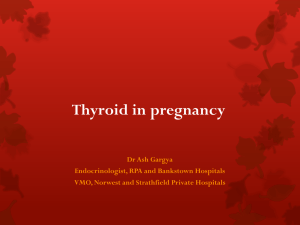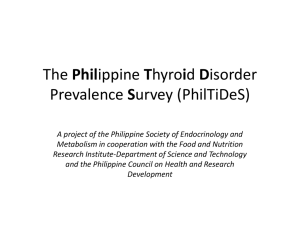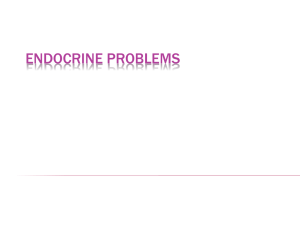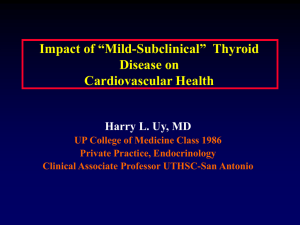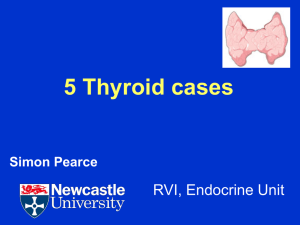Thyroid and Pregnancy
advertisement
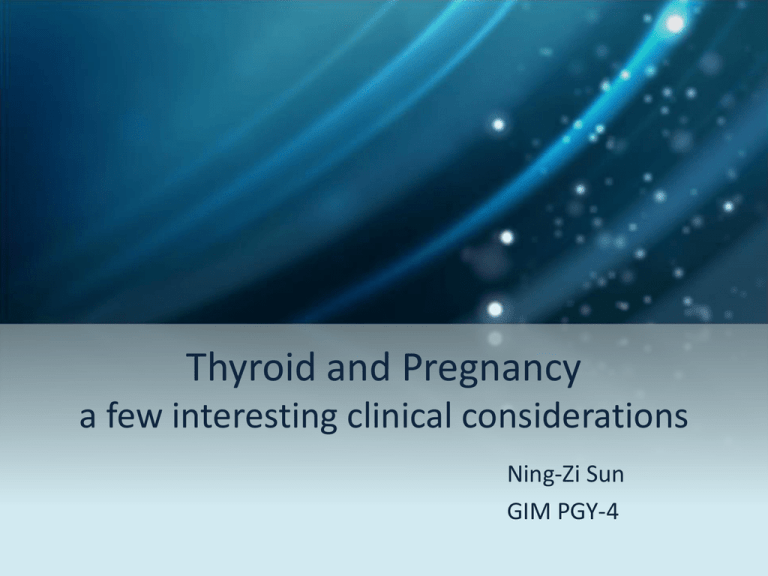
Thyroid and Pregnancy a few interesting clinical considerations Ning-Zi Sun GIM PGY-4 Objectives • Quick review of thyroid physiology in pregnancy • Addressing a few clinical questions: – Anti-TPO / Anti-Tg antibodies • spontaneous abortions • post-partum thyroiditis • optimization / Rx – Reference ranges for thyroid function tests in pregnancy – Pregnancy complications associated with subclinical hypothyroidism Thyroid physiology in pregnancy • • • • Increase in iodine requirement Decreased TSH because of action of bhCG Increase in total T4 due to increase in TBG and VD Normal range for TSH is lower: based on US data, 97.5%ile for normal TSH is 2.5 • T4, T3, TRH, iodine and TSH receptor ab cross placenta, but TSH does not • Until 18-20wk GA, fetus depends on maternal T4 • A maternal FT4 level <10%ile at 12 wk GA is associated with significant impairment of psychomotor development The Case (hypothetical) • 28F G0P0A0 pre-conception – Anti-TPO antibody titer of > 1000 – TSH 3.55 (normal) – T4 10.7 (normal) • Is she at higher risk of miscarriage? • Is she at higher risk of postpartum thyroiditis? • If yes, what can be done to decrease these risks? Is she at higher risk of miscarriage? • Presence of anti-TPO and / or anti-Tg antibodies increases the rate of spontaneous abortion from 3.38.4% to 13.3-17% • One study (Negro et al.) reported a RR of 4.95 • The association between presence of these antibodies and recurrent pregnancy loss (defined as 3 or more consecutive pregnancy losses prior to 20wk of gestation) is less clear • Cause of this association is uncertain: – ? failure of defective immune system to develop tolerance to fetus – ? mild, subclinical thyroid insufficiency Is she at higher risk of PP thyroiditis? • Baseline prevalence of postpartum thyroiditis ranges between 5-7% • The risk of developing postpartum thyroiditis increases to 30-50% if positive anti-TPO in early pregnancy Is she at higher risk of PP thyroiditis? Muller et al. What can be done for optimization? • Vaquero et al. looked at Rx options for prevention of miscarriage: – Design based on possible underlying pathophysiology – Study population consisted of women with positive anti-TPO and / or anti-Tg antibodies + history of recurrent miscarriages – Two treatment arms: IVIg vs thyroid supplement – End-point was live birth – Thyroxine appeared to be more effective (81% live births) than IVIg (55%) What can be done for optimization? • Negro et al. confirmed the effectiveness of thyroxine in reducing risk of miscarriage in anti-TPO positive women – Prospective design: euthyroid women with positive anti-TPO antibody treated with thyroxine (n=57) vs no treatment (n=58) vs normal controls (n=869) – Main outcome measure: rates of obstetrical complications – Anti-TPO positive women treated with thyroxine showed a similar rate of miscarriage (3.5%) as controls (2.4%) – Anti-TPO positive women not treated had a higher miscarriage rate (13.8%) consistent with what is reported in the literature – No treatment compared to thyroxine: RR of 1.72 for miscarriage – There appears to be also a significantly higher rate of premature deliveries among non-treated women (22.4%) as compared to those treated with thyroxine (7%) and normal controls (8.2%) What can be done for optimization? • Kampe et al. looked at effect of thyroxine for prevention post-partum thyroiditis: – Small study (only 18 women) – No change in the incidence or time course of postpartum thyroiditis What can be done for optimization? • According to the 2007 Endocrine Society Clinical Practice Guideline – the issue of universal screening for thyroid disease through TSH testing and possibly antibody testing remains unsettled • screening only those considered high risk would miss 30% of overt or subclinical hypothyroidism • prevalence of both overt thyroid disease in this population is 0.30.5% and that of subclinical hypothyroidism is 2-3% • prevalence of anti-TPO positivity is 10-15% but there is insufficient data pointing to the effectiveness of thyroxine treatment in this group of patient to justify the value of universal screening – for now, targeted case finding during early pregnancy (ongoing studies may alter this recommendation) – women with positive anti-TPO antibody should have a TSH level checked at 3 + 6mo PP (level A, grade 1 evidence) The Case (hypothetical) • The same patient is now 7-wk pregnant – TSH 3.25 – T4 9.7 • What are the reference ranges for thyroid function tests in pregnancy? • Which pregnancy complications is subclinical hypothyroidism associated with? What are the reference ranges for thyroid function tests in pregnancy? • Normal range for tot T4 is altered due to increase in TBG • The non-pregnant tot T4 range (50–150 nmol/L) should be adapted in T2 by multiplying by 1.5 • Reference ranges for free T4 is also different (mainly because of changes in TBG and serum albumin) – So far, no consensus has been reached for “trimester-specific” pregnancy ranges – Guidelines recommend • caution in the interpretation of serum free T4 • establishment of “laboratory-specific” and “trimesterspecific” reference ranges by each institution • Serum TSH values are changed by the thyrotropic action of bhCG, particularly (but not only) near end of the T1 What are the reference ranges for thyroid function tests in pregnancy? • Dashe et al. have proposed a nomogram for serum TSH changes during pregnancy What are the reference ranges for thyroid function tests in pregnancy? • Other authors have proposed to use “trimesterspecific” reference Which pregnancy complications is subclinical hypothyroidism associated with? • Leung et al. reported higher rate of gestational hypertension with subclinical hypothyroidism (25%) – Less than with overt hypothyroidism (36%) – Significantly more than the general population (8%) • They also reported a small association with low-birth weight birth – 22% with overt hypothyroidism – 9% with subclinical hypothyroidism – 7% in general population Which pregnancy complications is subclinical hypothyroidism associated with? • Casey et al. found that as compared to their euthyroid counterparts, untreated subclinically hypothyroid women were: – 3 times more likely found to develop placental abruption – 1.8 times more likely to have preterm labor (defined as labor before 37 completed weeks of gestation) • Kooistra et al. looked at the association between high TSH in the third trimester and breech presentation at delivery – Women with a TSH >90%ile (i.e. > 2.4 mIU/l) had a RR of 1.82 compared to women with a TSH below this cutoff What should we do for subclinically hypothyroid women? • According to study by Abalovitch et al., TREAT! – Retrospective cohort design – Looked at both overt and subclinical hypothyroidism – Outcome of interests were abortions and preterm deliveries 71% 60% 91% 100% • Data from Tan et al. suggests that adequate treatment may decrease the risk of obstetrical complications to the level of euthyroid women Very simple take-home messages • Presence of anti-TPO and / or anti-Tg antibodies significantly increases the risk of miscarriage even in euthyroid state • Women with anti-TPO and / or anti-Tg antibodies are at higher risk of developing post-partum thyroiditis and should have TSH level checked at 3 and 6 months post-partum • The reference ranges used for thyroid functions are derived from non-pregnant population data and can lead to misdiagnosis • Should call local laboratory for lab-specific and trimester-specific ranges (though most laboratories have not developed these) • Subclinical hypothyroidism is associated with increased risk of many obstetrical complications (including gestational HTN, spontaneous abortion, placenta abruption, preterm delivery, need for c-section) • Adequate treatment with thyroxine decreases the risk of these complications (possibly to the same level as the general population) Reference • • • • • • • • • • • • • • • Muller et al. Consequences of Autoimmune Thyroiditis in Pregnancy. Endocrine Reviews. 2001; 22(5):605–630 Victor et al. Low maternal free thyroxine concentrations during early pregnancy are associated with impaired psychomotor development in infancy. Clinical Endocrinology. 1999; 50:149-155 Vaquero et al. Mild thyroid abnormalities and recurrent spontaneous abortion: diagnostic and therapeutical approach. Am J Reprod Immunol. 2000; 43:204-208 Haddow et al. Maternal Thyroid Deficiency during Pregnancy and Subsequent Neuropsychological Development of the Child. The New England Journal of Medicine. 1999; 31(8):549-555 Kampe et al. Effects of L-thyroxine and iodide on the development of autoimmune postpartum thyroiditis. J Clin Endocrinol Metab. 1990; 70:1014–1018 Negro et al. LT4 in Autoimmune Thyroid Disease during Pregnancy. J Clin Endocrinol Metab. 2006; 91(7):2587– 2591 Abalovich et al. Management of Thyroid Dysfunction during Pregnancy and Postpartum: An Endocrine Society Clinical Practice Guideline. J Clin Endocrinol Metab. 2007, 92(8) Sutandar et al. Hypothyroidism in Pregnancy. JOGC. 2007; 354-356 LeBeau et al. Thyroid Disorders During Pregnancy. Endocrinol Metab Clin N Am. 2006; 35:117-136 Leung et al. Perinatal outcome in hypothyroid pregnancies. Obstet Gynecol. 1993;81:349 Casey et al. Subclinical hypothyroidism and pregnancy outcomes. Obstet Gynecol 2005;105:239 Kooistra et al. High thyrotrophin levels at end term increase the risk of breech presentation. Clinical Endocrinology. 2010; 73:661-665 Idris I, Srinivasan R, Simm A, Page RC. Maternal hypothyroidism in early and late gestation: effects on neonatal and obstetric outcome. Clin Endocrinol 2005; 63(5):560–565 Abalovich et al. Overt and Subclinical Hypothyroidism Complicating Pregnancy. Thyroid. 2002; 12(1):63-68 Tan et al. Are women who are treated for hypothyroidism at risk for pregnancy complications? Am J Obstet Gynecol 2006; 194(5):e1-e3



